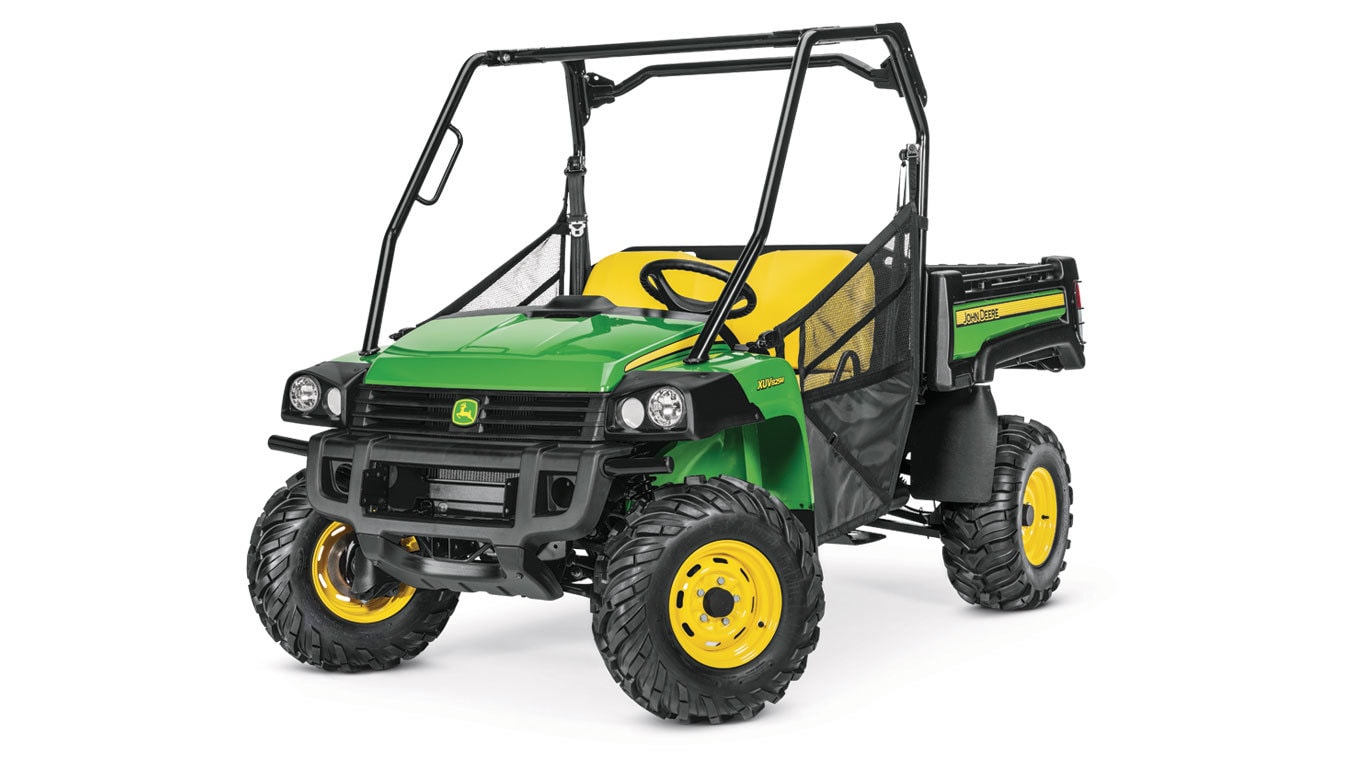Overview
- Advanced Engine System
- Superior Terrain Capability
- Deluxe Cargo Box Versatility
Features
Features
Powerful gas engine delivers superb starting, idling, and throttle response
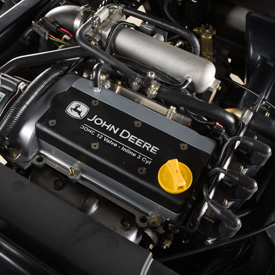 812-cc (49.6-cu in.) gasoline engine
812-cc (49.6-cu in.) gasoline engine
The machine is powered by an 812-cc (49.6-cu in.), 3-cylinder, dual overhead cams, liquid-cooled, four-cycle gasoline engine. It produces 6.5 kgm (47 lb-ft) of torque at 3200 rpm. The advanced electronic controls and fuel-injection system deliver superb starting, idling, and throttle response during operation.
The engine offers the following performance and reliability features:
-
38.8 kW (52 hp*) at 6000 rpm
-
71-km/h (44-mph) top speed
-
Electronic fuel injection for superb performance, altitude adjustment, and cold-weather starting (tested to -28.9°C [-20°F])
-
Electronic ignition is continuously variable for optimum engine power and provides fast, reliable starts
-
Overhead valve design provides greater efficiency and fuel economy
-
Full-pressure lubrication system
-
Spin-on oil filter with drain bracket and oil drain plug enable easy servicing
-
Dry, replaceable, single-element air cleaner with remote intake
-
See-through coolant recovery tank permits the operator to check the coolant level without having to remove the radiator cap
-
Open radiator compartment for air flow
-
-
Standard high-capacity alternator - 85 amps for maximum accessory capability
* The engine horsepower information is provided by the engine manufacturer to be used for comparison purposes only. The actual operating horsepower will be less.
Dual A-arm front and rear suspension provides a smooth ride over challenging terrain and excellent hauling characteristics
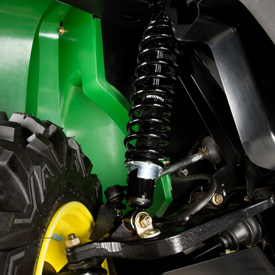 XUV front suspension detail
XUV front suspension detail

To complement the most capable frame available in a high-performance utility vehicle, the XUV is equipped with four-wheel independent suspension.
A dual A-arm front and rear suspension provides a smooth ride over challenging terrain and excellent hauling characteristics.
The entire suspension system has been optimized to handle no cargo to maximum cargo without compromising ride quality or vehicle stability.
Dual A-arm front suspension features include:
-
203.2 mm (8 in.) of travel provides ample compression and wheel extension, which keep all four wheels on the ground for superior traction and vehicle control
-
17.5-mm (0.6875-in.) solid anti-roll bar with fully rubber isolated connecting links and pivots for minimal vehicle body roll and quiet operation
-
Heavy-duty, nodular cast-iron knuckles to support the strut, constant-velocity (CV) shaft, and wheel
-
Maintenance-free rubber torsional A-arm pivots for long life and quiet operation
-
CV shaft protection from sticks that may puncture the rubber boot
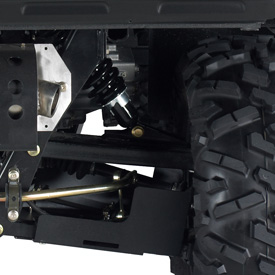 XUV rear suspension detail
XUV rear suspension detail

Dual A-arm independent rear suspension features include:
-
Unequal length, dual A-arm construction for superior wheel control and travel
-
228.6 mm (9 in.) of total travel provides ample compression and wheel extension, which keep all four wheels on the ground for superior traction, excellent ride quality, and vehicle control
-
Coil-over shocks absorb the most demanding terrain
-
A-arms made from square/rectangular tubing reduce weight while remaining rigid
-
Heavy-duty, nodular cast-iron uprights support wheel loads with a double row of ball bearings
-
CV driveshaft protection from sticks that may puncture the rubber boot
-
Rear sway bar for lateral stability
Superior terrain capability
The Gator™ XUV Crossover Series Utility Vehicle has a precision-engineered drivetrain system that fully utilizes engine power, optimizing acceleration, hauling, towing, and hill-climbing capabilities. Power is transmitted from the engine through a continuously-variable clutch system to the transaxle.
Key elements of the drive system include:
Variable-speed drive
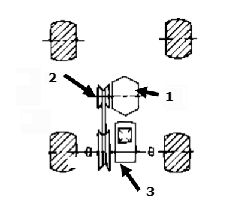 Variable-speed drive
Variable-speed drive
The variable-speed drive consists of two clutches and a drive belt:
- Drive clutch is attached to the engine.
- Driven clutch is attached to the transaxle.
Features include:
- The engine braking system utilizes a tight belt for operation, requiring an idler sleeve on the primary clutch for neutral. The secondary clutch is a new build-on-shaft design that utilizes a cam to tune the acceleration and deceleration of the vehicle. The clutch will stay engaged, providing deceleration until approximately 5 km/h (3 mph).
- The continuously variable transmission (CVT) air intake draws in 50 percent more air versus previous designs to reduce heat and the amount of water ingestion into the CVT system. The system will reduce belt slippage and improve durability.
- A low- and high-speed forward gear offering:
- Low range is 0 km/h to 43 km/h (0 mph to 27 mph), XUV825E and XUV825M S4
- Low range is 0 km/h to 24 km/h (0 mph to 15 mph), XUV855E and XUV855M S4
- High range is 0 km/h to 71 km/h (0 mph to 44 mph), XUV825E and XUV825M S4
- High range is 0 km/h to 51 km/h (0 mph to 32 mph), XUV855E and XUV855M S4
- Ability to creep along slowly to maneuver in tight spaces
- Standard full-clutch enclosure with high speed fan provides longer belt and clutch life
- High-ratio clutches with three cam weights for maximum belt clamp load in high-torque conditions
- Powertrain reduction ratios:
- The complete reduction ratios range for high gear is 8.6:1 at top speed and 42:1 at initial clutch engagement. This varies between the vehicles listed above.
- The complete reduction ratios range for low gear is 17.9:1 at top speed and 86.8:1 at initial clutch engagement. This varies between the vehicles listed above.
NOTE: Delivery and torque to the ground depends on tire size, which is a function of nominal size and pressure.
How the variable-speed drive works:
- As engine speed increases, the spring-loaded drive clutch is closed by weights being forced out by centrifugal force.
- As the drive clutch closes, the belt rides up to the largest diameter of the drive clutch and forces open the driven clutch.
- With the belt running in the smallest diameter of the driven clutch, the speed being transferred to the transaxle is increased.
- The driven clutch is designed to sense varying loads (inclines, mud, etc.) and constantly adjusts drive speed upward or downward so that engine rpm remains optimal.
Transaxle, mechanical front-wheel drive (MFWD), and constant-velocity (CV) shafts
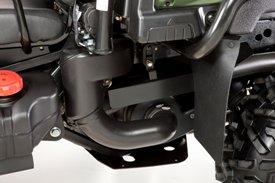 Side view of CVT intake and clutch on closure (XUV855 shown)
Side view of CVT intake and clutch on closure (XUV855 shown)
 Front differential rocker switch
Front differential rocker switch
 Rear end shot of transaxle/CV shafts
Rear end shot of transaxle/CV shafts
Operator interface
-
On-demand true four-wheel drive (4WD) system with an auto-locking front differential and dash-mounted electronic rocker switch is best in class; when the rocker switch is in the on 4WD position, the front differential will automatically lock for extra traction when needed, but when the rocker switch is in the off two-wheel drive (2WD) position, the vehicle will remain in 2WD
-
Provides exceptional traction in challenging conditions
-
Maintains turf-friendly operation in 2WD mode
-
Illuminated for visibility in low-light conditions
-
Transaxle
-
Two-speed, fully-enclosed, oil bath transaxle allows for superior pulling ability
-
Cast-aluminum design is the most robust in the industry
-
Helical forward and reverse gears are used for quiet operation
-
Rear traction assist (differential lock) is built in and can be engaged on demand
-
Allows locking the rear drive wheels together
-
Provides increased traction in tough spots
-
NOTE: Differential design reduces scuffing of the turf during turns because it allows the inside wheels to turn slower than the outside wheels
-
-
Neutral start safety interlock for engine ignition system
-
Large, sealed bearings are located inside the housing for better protection and durability
-
Contains gear case for transferring power to the MFWD
-
Splined shaft interfaces for maximum torque transfer and durability
-
All drive gears machined from highest grade gear steel
-
Protected by a skid plate
-
-
MFWD
-
Electronic design is auto-locking for ease of use
-
Performs like a locking differential when engaged, but like an open differential when cornering
-
Offers positive engagement of both front wheels in forward and reverse as a differential package
-
Automatic engagement on the fly—no shift linkages required
-
-
Protected by a skid plate and frame
-
-
Drive shafts
-
Rear CV shaft diameter measures 27 mm (1.1 in.) and is designed for peak engine and braking torque
-
Front CV shaft diameter measures 23.9 mm (0.94 in.) and is designed for peak engine torque
-
Propshaft (transaxle to MFWD shaft) diameter measures 23 mm (0.91 in.) and is designed for peak engine torque
-
All CV shaft and propshaft joints are maintenance free and protected by exclusive Neoprene boots for durability
-
Extra-durable deluxe cargo box ensures hard-working performance and longevity
 Deluxe cargo box (XUV825 camo shown)
Deluxe cargo box (XUV825 camo shown)

The deluxe cargo box consists of a 15 percent glass-filled polypropylene composite material that eliminates rust, dents, and reduces noise.
Deluxe cargo box tailgate
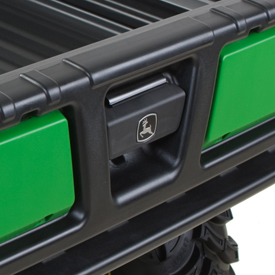 Tailgate handle
Tailgate handle
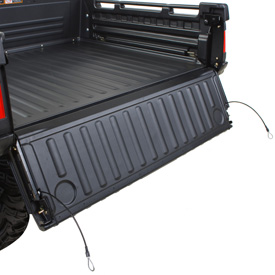 Tailgate lowered to 150 degrees
Tailgate lowered to 150 degrees
The tailgate can be opened or removed for easier cleanout and to carry longer items. The tailgate has been improved, features truck-like performance, and can be operated with one hand.
The standard-installed lanyards can also be removed to lower the tailgate to 150 degrees for convenient loading and unloading tasks.
Deluxe cargo box tilt
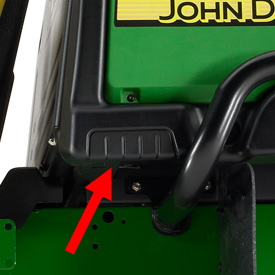 Integrated handle for manual cargo box tilt
Integrated handle for manual cargo box tilt

The deluxe cargo box is easier to latch, unlatch, raise, and lower with the integrated handle design and gas assist.
A prop rod is provided to hold the box in the upright position for operator convenience, as well as to limit box pivot travel.
Integrated tie-down points
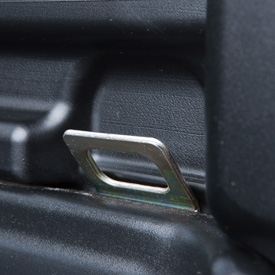 Integrated tie-down point in cargo-box bed
Integrated tie-down point in cargo-box bed
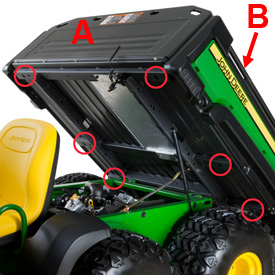 Additional tie-down points (TH 6X4 shown)
Additional tie-down points (TH 6X4 shown)
The deluxe cargo box offers integrated tie-down points for increased versatility. Tie-down points are located in the following areas:
- Four corners inside the cargo box bed
- Four points on the load guard directly behind the operator station (A)
- Tie-down bars on either side of the cargo box (B)
- Six points on the underside of the cargo box frame (circled)
Converting deluxe cargo box to a flat bed
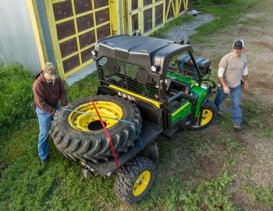 Deluxe cargo box converted to a flat bed (XUV 825 shown)
Deluxe cargo box converted to a flat bed (XUV 825 shown)
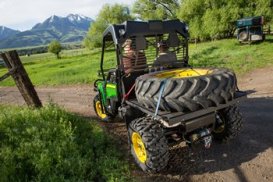 Deluxe cargo box converted to a flat bed (XUV825 shown)
Deluxe cargo box converted to a flat bed (XUV825 shown)
The deluxe cargo box easily converts to a flat bed. The flatbed configuration allows loading larger cargo.
Optional accessories
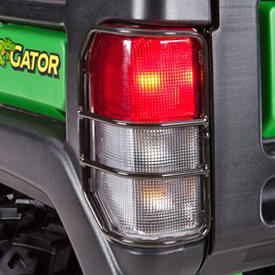 Brake and taillight with optional protector
Brake and taillight with optional protector
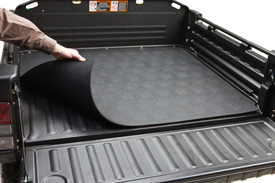 Bed mat—protects the steel floor from dents
Bed mat—protects the steel floor from dents
 Cargo box power lift
Cargo box power lift
 Cargo box power lift
Cargo box power lift
Optional accessories for the deluxe cargo box include:
- Factory-installed brake and taillight
- Factory-installed spray-in liner (not shown)
- Improves skid resistance and surface abrasion protection
- Cargo box bed mat
- Cargo box power lift
Specifications
| Length | 1143 mm (45 in.) |
| Width | 1320 mm (52 in.) |
| Depth | 304 mm (11 in.) |
| Volume | 0.46 m3 (16.4 cu ft) |
| Weight capacity | 454 kg (1000 lb) |
| Dump angle | 47 degrees |
CAUTION: Carrying extra-long cargo that extends beyond the box can adversely affect stability.
Equipped with power steering
This Gator™ XUV Crossover Utility Vehicle is equipped with power steering and a dual A-arm front suspension. These automotive-type systems exhibit excellent handling characteristics, as well as responsive steering and low steering effort:
-
Steel ball bearings secure the steering shaft and deliver smooth, responsive operation
-
Completely-sealed rack-and-pinion for long life
- Low steering ratio (lock-to-lock) provides more responsive steering and less operator input
-
Shaft U-joints are phased for a smooth, uninterrupted motion of the steering wheel
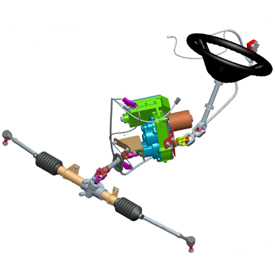 Electric power-assist steering system
Electric power-assist steering system

Electric power-assist steering (EPAS) system has advanced features:
- Anti-kickback feature reduces the amount of steering unwinding when traversing difficult terrain.
- The system is speed sensing and adjusts steering effort as the speed of the vehicle changes.
- As speed increases, there is less steering assist for improved road feel.
- As speed decreases, steering assist increases to give lower steering efforts for improved maneuverability.
- A warning/functional light on the instrument panel provides self-diagnostics and a warning light in the situation of no assist.
- Torque sensor measures steering wheel input so the on-board computer can provide the appropriate output for various driving situations.
With the EPAS system, the operator maintains a direct, mechanical linkage from the steering wheel to the front wheels. The power-steering system interfaces mechanically with the steering system by being inserted between the steering wheel and the rack-and-pinion assembly.
A differential torque sensor is integrated into the power steering assembly. The circuit board assembly is also integral with the power-steering assembly.
Power steering does not reduce turning radius but significantly reduces steering effort by approximately 85 percent compared to those models without power steering.
EPAS interface diagram
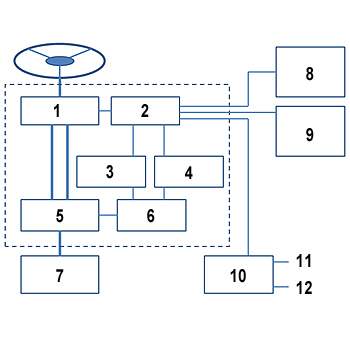 EPAS interface diagram
EPAS interface diagram
The numbered descriptions refer to the EPAS interface diagram shown above:
- Torque sensor
- Engine control unit (ECU)
- Fail-safe relay
- Current/thermal control circuit
- Reduction gears
- DC motor
- Rack and pinion
- Function/warning light
- Key power and ground
- Vehicle speed sensor
- Instrument cluster
- Relay module

